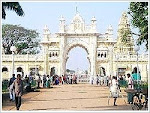Situated among fertile fields, and skirted by wooded hills, Mysore was the capital of the Woodward rulers, who were governors of Southern Karnataka under the Aviary Kings. The Woodward dynasty ruled almost uninterrupted from 1399 until Independence, except for the 38-year rule of the Muslim warlord Hider Ali and his son, Tip Sultan, in the 18th century. Modern Mysore is the creation of Tip Sultan who, in 1793, leveled the old city and built the present town. Today, my sore is an important cultural Centrex, with the largest university in Karnataka. It is also renowned for its ivory work, silk-weaving, sandalwood incense and carvings.
Several elegant public buildings, erected under the Woodenwares, enhance the wide, tree-lined streets. In the heart of the city is the Ameba Villas Palace. To its west is Agama Palace, built in 1902 to mark the coronation ceremony of Krishna raja III. It partly obscures a neo-classical structure, now the Cameramen Art Gallery, which houses an interesting collection of disparate objects including antique furniture, musical instruments, ceramics and ivory. On its top floor is a splendid collection of musical instruments, as well as magnificent paintings by the renowned 19th century artist from Errata, Raja Ra vi Vera.
Near the northwestern corner of Ameba Villas Palace is Krishna raja Circle, where a statue of Krishna raja Woodward stands beneath a pavilion. The Ayah Ra road that leads out from this circle is the principal shopping Centrex of the town. A short distance away is the Government House, the seat of the British Residents from 1805. Nearby, the Cathedral of St. Phenomena, with a stained-glass interior, is a new Neo-Gothic structure, completed in 1959.
In the Western part of the city is the Neo-Classical Ma nasa Angostura, the campus of My sore University. The Oriental Research Institute here houses a collection of Sanskrit manuscripts, while the Folklore Museum has one of the most important ethnographic collection of South Indian toys, Puppets and household objects, as well as toe wooden Chariots. On the way to Chapman Hill, 3 km (2 miles) southeast of My sore, is Plait Ma hal Palace, built in 1930. Formerly a private royal guest house, it is now a hotel. About halfway up the hill is the Nandi monolith, dating to 1659. Carved out of a single boulder, it is 7.5 am (25 ft) long and 5 am (16 ft) high. The richly decorated bull is depicted crouching. The Channels Temple, at the summit of the hill, was built in the 17th century by the Woodenwares and was later refurbished. It houses a beautifully decorated idol of Channels, the family deity of the Wodeyar kings.
Prime Attractions
Mysore is more than palaces, parks and temples; the exotic fragrance of Mysore Jasmine; the melodious strains of the Veena; the rich aroma of filter coffee; traditional carvings on fragrant sandalwood, rosewood and ivory; the rustle of rich silks; delicious Nanjangud bananas; Hot 'N' Spicy Bisi-bele-hulianna; mouth watering Mysore Pak, a traditional sweetmeat; It is a gourmet's delight and a Shopper's paradise. Shop at Cauvery Handicrafts Emporium or in the little backstreets and bylanes that offer some exciting bargains. Mysore Come, experience it for yourself.
Steeped in history Mysore, capital city of the Wodeyars. Abode of untold grandeur and glory, where the rich heritage of the Wodeyars is carefully preserved to this day in its magnificent places, beautifully laid-out gardens, imposing buildings, board shady avenues and sacred temples.
There's an old world charm about the city that reaches out and leaves no one untouched. Mysore, or Mahishur as it was called then, traces its history back to the mythical past, when Goddess Chamundeshwari of Chamundi Hills killed the wicked buffalo-headed Demon, Mahishasura.
Mysore Dasara is the celebration of this victory of good over evil. Mysore also has associations with the Mahabharata and King Ashoka of the 3rd century B.C. during the Wodeyar rule. Mysore reached the zenith of its glory as a fabled centre of oriental splendour.
Pomp and Pageantry relived come to Mysore in October when the tranquil city awakens to ten days of Dussehra festivities. Brilliantly lit up palaces, decorated arches, festooned streets, colourful costumes and cultural shows…classical music, folk dances, Bharat Natyam, Yakshagana, Huthari, Torch Light Parade, Theppotsava… The culmination is the legendary Mysore Dussehra procession with caparisoned elephants, the golden howdah, decorated horses, stately coaches, troops in ceremonial uniforms, folk dancers and colourful floats.
Sunday, September 21, 2008
Subscribe to:
Posts (Atom)

